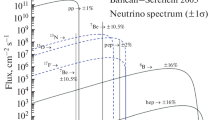Abstract
Neutrinos play an important role in the evolution of Universe. High precision modern cosmological measurements are very important source of information of such neutrino properties as the number of neutrino flavors and the sum of neutrino masses. In this review we consider the basics of the cosmology (Friedman–Robertson–Walker metric, Friedman equations and their solutions, early Universe and neutrino decoupling, Big Bang Nucleosynthesis, Cosmic Microwave Background Radiation etc.), discuss the physical basis of the cosmological determination of neutrino properties and present latest value of the number of neutrino flavors and bounds on the sum of neutrino masses \(\sum\nolimits_i {{{m}_{i}}} \).

Similar content being viewed by others
Notes
The cosmological principle was formulated by A. Einstein in 1917. At that time astrophysicists thought that the Universe is composed of stars. Evidence for the existence of Galaxies came later.
1 pc = \(3.26\,\,{\text{light}}\,\,{\text{years}} = 3.09 \times {{10}^{{16}}}{\kern 1pt} {\text{m}}\).
From (56) and (58) follows that \({{\rho }_{c}} \simeq 0.86 \times {{10}^{{ - 26}}}\,\,{\text{kg}}\,\,{{{\text{m}}}^{{ - 3}}}\).
In 2011 for discovery of the accelerating expansion of the Universe the Nobel Prize was awarded to S. Perlmutter, B. Schmidt and A. Riess.
Notice that from analysis of cosmological data it was found [4] that \({{w}_{{mbda}}} = - 1.028(31)\).
A condition for the thermal equilibrium in the expanding Universe we will discuss later.
We use the following definition: \(\Delta m_{{ki}}^{2} = m_{i}^{2} - m_{k}^{2}\).
Notice that stable nuclei heavier than \(^{{\text{7}}}{\text{Li}}\) in the BBN practically are not produced. It is connected with the fact that stable nuclei with atomic numbers 5 and 8 do not exist. This prevent production of nuclei heavier than \(^{{\text{7}}}{\text{Li}}\) in \(p + {{\,}^{4}}{\text{He}}\), \(^{{\text{4}}}{\text{He}} + {{\,}^{4}}{\text{He}}\) and other reactions.
Notice that in the hydrogen recombination era helium atoms were not ionized (the ionization energy of helium is larger than that of hydrogen.)
In the same year D. Hilbert derived the equations of the General Relativity from a variational principle [30].
REFERENCES
A. D. Dolgov, “Neutrinos in cosmology,” Phys. Rept. 370, 333 (2002).
J. Lesgourgues and S. Pastor, “Massive neutrinos and cosmology,” Phys. Rep. 429, 307 (2006).
S. Hannestad, “Neutrino physics from precision cosmology,” Prog. Part. Nucl. Phys. 65, 185 (2010).
M. Tanabashi et al. (Particle Data Group), “Review of particle physics, astrophysical constants and parameters,” Phys. Rev. D 98, 030001 (2018).
B. Pontecorvo, “Inverse beta processes and nonconservation of lepton charge,” Sov. Phys. JETP 7, 172 (1958).
Z. Maki, M. Nakagawa, and S. Sakata, “Remarks on the unified model of elementary particles,” Prog. Theor. Phys. 28, 870 (1962).
I. Esteban, M. C. Gonzalez-Garcia, M. Maltoni, T. Schwetz, and A. Zhou, “The fate of hints: Updated global analysis of three-flavor neutrino oscillations” (2020), arXiv:2007.14792 [hep-ph].
P. F. de Salas and S. Pastor, “Relic neutrino decoupling with flavour oscillations revisited,” JCAP, 07, 051 (2016).
S. S. Gershtein and Ya. B. Zeldovich, JETP Lett. 4, 120 (1966).
M. Aker et al. [KATRIN Collab.], “An improved upper limit on the neutrino mass from a direct kinematic method by KATRIN,” Phys. Rev. Lett. 123, 22180 (2019); arXiv:1909.06048 [hep-ex].
R. H. Cyburt, B. D. Fields, K. A. Olive, and T. H. Yeh, “Big Bang nucleosynthesis: 2015,” Rev. Mod. Phys. 88, 015004 (2016); arXiv:1505.01076.
P. A. Zyla et al. (Particle Data Group), “Review of particle physics,” Prog. Theor. Exp. Phys., 083C01 (2020).
S. Agarwal and H. A. Feldman, “The effect of massive neutrinos on the matter power spectrum,” Mon. Not. R. Astron. Soc. 410, 1647 (2011); arXiv:1006.0689.
J. Lesgourgues and S. Pastor, “Neutrino cosmology and Planck,” New J. Phys. 16, 065002 (2014); arXiv: 1404.1740.
E. Baracchini et al. (PTOLEMY Collab.), “PTOLEMY: A proposal for thermal relic detection of massive neutrinos and directional detection of MeV dark matter” (2018); arXiv:1808.01892 [physics.ins-det].
N. Aghanim et al. (Planck Collab.), “Planck 2018 results. VI. Cosmological parameters,” Astron. Astrophys. 641, A6 (2020); arXiv:1807.06209, [astro-ph.CO]; https://doi.org/10.1051/0004-6361/201833910
S. Alam et al. (BOSS Collab.), “The clustering of galaxies in the completed SDSS-III Baryon Oscillation Spectroscopic Survey: Cosmological analysis of the DR12 galaxy sample,” Mon. Not. R. Astron. Soc. 470, 2617 (2017); arXiv:1607.03155 [astro-ph.CO].
G. F. Smoot et al. (COBE Collab.), “Structure in the COBE differential microwave radiometer first year maps,” Astrophys. J. 396, L1 (1992).
C. L. Bennett et al. (WMAP Collab.), “First year Wilkinson Microwave Anisotropy Probe (WMAP) observations: Preliminary maps and basic results,” Astrophys. J. Suppl. 148, 1 (2003); arXiv:astro-ph/0302207.
A. G. Doroshkevich, Ya. B. Zel’dovich, and R. A. Sunyaev, Sov. Astron. 22, 523 (1978).
W. Hu and M. J. White, “Measuring the curvature of the Universe” (1996), arXiv:astro-ph/9606140.
P. A. R. Ade et al. (BICEP2 and Keck Array Collabs.), “BICEP2/Keck Array V: Measurements of B-mode polarization at degree angular scales and 150 GHz by the Keck array,” Astrophys. J. 811, 126 (2015); arXiv: 1502.00643 [astro-ph.CO].
S. Naess et al. (ACTPol Collab.), “The Atacama cosmology telescope: CMB polarization at \(200 < \ell < 9000\),” J. Cosmol. Astropart. Phys., 10, 007 (2014); arXiv:1405.5524 [astro-ph.CO].
A. T. Crites et al. (SPT Collab.), “Measurements of E‑mode polarization and temperature-E-mode correlation in the cosmic microwave background from 100 square degrees of SPTpol data,” Astrophys. J. 805, 36 (2015); arXiv:1411.1042 [astro-ph.CO].
I. Esteban, M. C. Gonzalez-Garcia, M. Maltoni, T. Schwetz, and A. Zhou, “The fate of hints: Updated global analysis of three-flavor neutrino oscillations” (2020), arXiv:2007.14792 [hep-ph].
M. Tanabashi et al. (Particle Data Group), “Neutrino in cosmology,” Phys. Rev. D 98, 030001 (2018).
P. A. M. Dirac, General Theory of Relativity (Princeton Univ. Press, 1996).
L. D. Landau and E. M. Lifshitz, Classical Theory of Fields (Pergamon Press, Oxford, 1975).
Ya. B. Zel’dovich and I. D. Novikov, Relativistic Astrophysics (Univ. Chicago Press, Chicago, 1983), Vol. II.
D. Hilbert, Nachr. Ges. Wiss. Goettingen, Math.-Phys. Kl., 395–407 (1915).
Author information
Authors and Affiliations
Corresponding author
Rights and permissions
About this article
Cite this article
Bilenky, S.M. Neutrino in Cosmology. Phys. Part. Nuclei 52, 337–356 (2021). https://doi.org/10.1134/S1063779621030035
Received:
Revised:
Accepted:
Published:
Issue Date:
DOI: https://doi.org/10.1134/S1063779621030035



